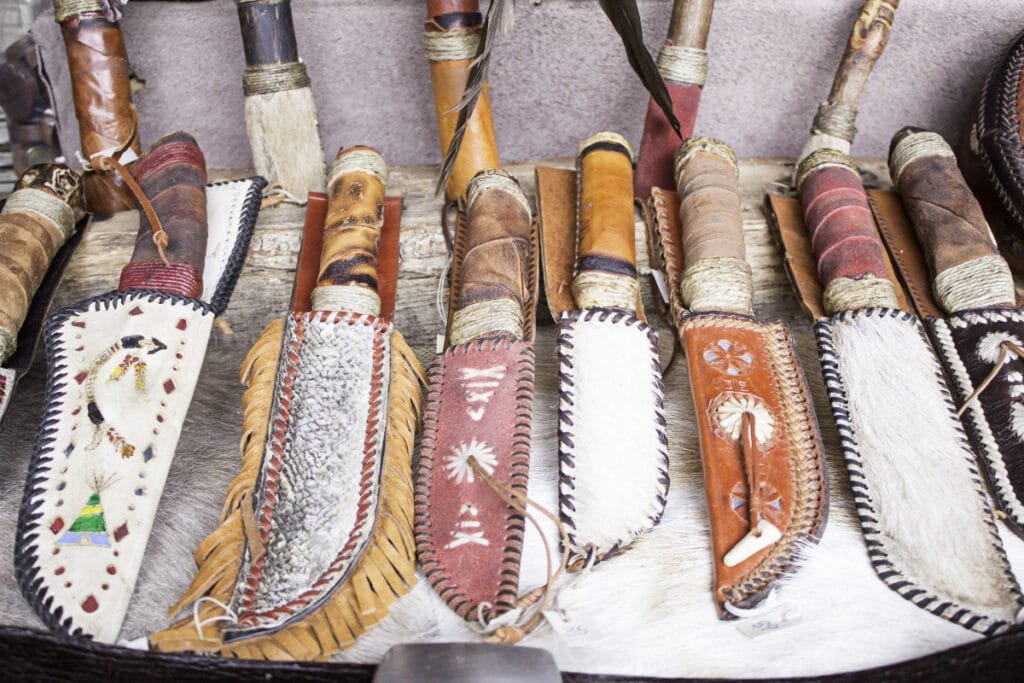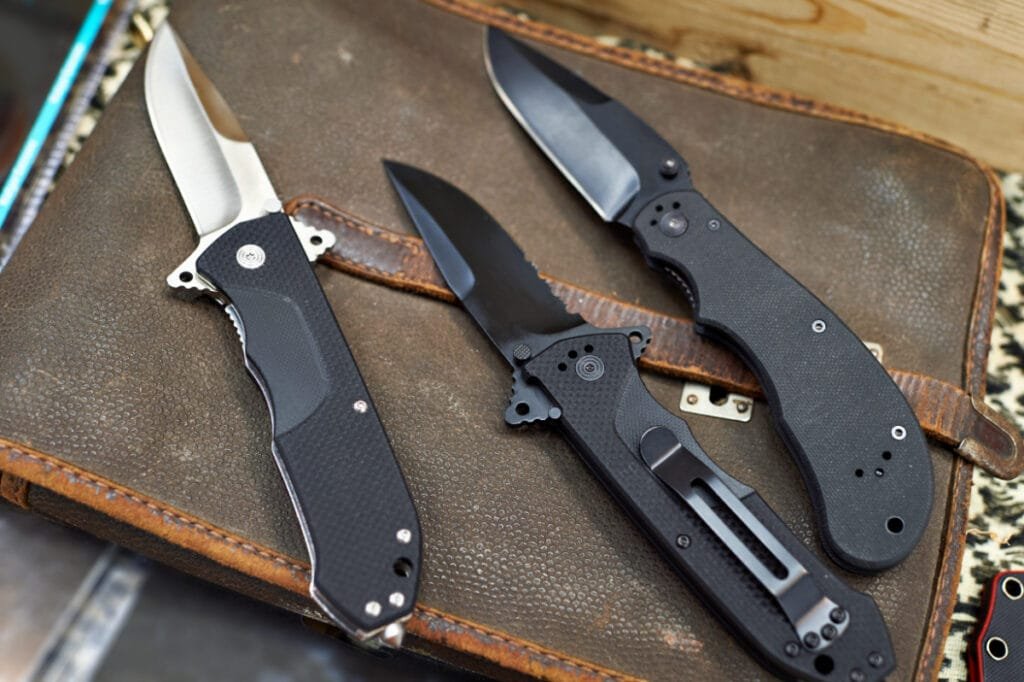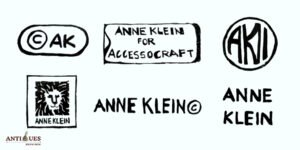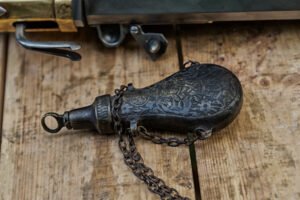Can you imagine your day without a knife? It’s hard, right? After all, this small tool is a boon in the kitchen! But knives weren’t always this small and handy. In fact, if you see an old knife, you’ll notice its dagger-sharp blades and handles.
So, these models were pretty costly back then. But guess what? They are even more precious now! Thanks to their unique design, age, and make.
So, if you have your eyes on antique knives and want to know how to spot and value one, you’ve arrived at the right place. Today, I’ll help you spot authentic antique knives for good resale. So let’s dive in!
Key Takeaways
- You can spot antique knives by their thick metallic blades, wood or metal handles, and carvings. You can also look for minor, handmade imperfections and metal sheaths to identify them.
- Weapon-like or dagger knives with bare metal, wood, or black handles are valuable. But even carved and composite gold and silver blades are costly.
- Pick gold, cast iron, or alloyed steel knives for a good value! And you can even go with rare or royal-origin knives to hike the cost.
- Bowie, Fantasy, or Folding knives are costly. But regular pocket or kitchen knives are easy-to-get and cheaper. You can also look for stamped dates and logos to track the age and value clearly.
Key Features of Old Antique Knives
What do you think old knives look like? If you said thick and curved, you’re right! Antique knives are very sturdy and sharp. Unlike the flexible, steel knives of today! But that’s not it! You can also expect them to be ornate and loaded with gold and silver.
Vintage knives mostly come with cases and metal sheaths. And, if you look closely, you’ll see the stamped dates and logos that tell their story!
What Other Features to Look for in Vintage Knives?
- Iron, Bronze, Brass, Ceramic, and Copper blades with a curved finish
- Wood, Bone, or Ivory handles with a lot of carving
- Golden carvings and stone-studded flowers or birds on the handles
- Sterling Silver, copper, and golden details on the knife case
- Crude and rough blades with a lot of imperfections and bumps
The History & Evolution
Antique knives date back to the Stone Age. But, it was only during the 1700s that they became handy for table use. So, makers replaced the iron or ivory handles with simple wood and bone. But they weren’t that durable and faded easily.
It was in the 1750s that makers explored the use of metals. Then, copper and bronze knives with steel handles became common. This period, known as the modern era, made old knives more popular!
The later 19th-century knives were mostly minimal! They no longer had the carvings but had branded gold and diamond cases. So, such signed knives are obviously valuable today.
6 Types of Vintage Knives (With Values)
There are many rare types of antique knives, right from the 17th Century. And each has a different shape and pattern that affects its worth. Let’s take a look at all these types!
1. Pocket Knife
Antique pocket knives are small, about 3-5 inches in size. They mostly come in wood or steel handles and cases. You’ll also see some grooves and jagged cuts on the handles, plus they also feature foldable blades. These types of vintage knives cost around $600 – 700.
2. Kitchen Knife
You might know the typical fruit and vegetable knives. Well, old kitchen knives look nearly the same but have rugged edges and circular handles, making them special. You’ll also find a thicker blade and a simple geometric design with this one.
But since they are new and factory-made, they cost less, only around $100 – 500.
3. Military Knife

Military knives are thick and heavy knives with jagged blades and leather straps and cases. You can also find some linear grooves, thick wood carvings on their handles and casings.
But military knives turn brownish and lose their shine with age. These knives are relatively cheaper, around $200 – 300.
4. Bowie Knife
Just as the name suggests, Bowie knives are curved knives with bow ties at the blade bottom. They come with an umbrella-shaped handle and have small seams, making them light and handy.
But since they are hand-shaped, they are precious and cost around $2000 – 3000.
5. Fantasy Knife
Fantasy knives are fictional or dragon-themed knives with intricate designs. Gold or silver bladed, these British knives cost $1500 – 2000 with their unique designs.
6. Folding Knife

You’ll spot folding knives with their rotating blades, metal bodies, and geometrical handles. They are not that sturdy but are very lightweight and portable. So, you can expect a rough valuation of $500 – 1000 for them.
7 Factors to Identify a Vintage Knife & Assess Its Worth
Vintage knives have distinct blades and handles that affect their demand and value. So, if you want to find the worth of your knife, you must know these seven factors!
1. Manufacturing Date & Age
The sharper and rougher the knife, the more precious it is! That means bare metal knives with thick handles, and curved blades from the 1800s are the most valuable. And you’ll also fetch a good value if there are any hand polish stains on the surface.
But, the thin, factory-made knives from the 1900s were small and blunt. They are mass-produced, so they have a lower demand. So, most of them are affordable, valuing $500 – 600.
How Do You Identify Knives from the 1700s?
You can spot these knives by their bone or ceramic handles and weapon-like blades, most of which are curved. Plus, you can look for uneven blade surfaces and natural motifs to spot them. Ill-fitting casings and pointed 5-6 inch blades are also common.
How Do You Spot Knives from the 1800s?
Look out for straight, blunt blades and rounded tips to spot these easily. You can also look for golden or silver handles and signed seams to spot them. And, if you’re lucky, you can get trademark numbers to track their age and make.
How Do You Identify Knives from the 1900s?
These knives are pocket-sized and have thin blades and rectangular handles. Most of them are very polished, short-gripped, and minimal. But they have low demand, valuing about $100 – 200.
Let’s look at the common trademark numbers for easy reference:
| Year | Knife Age | Trademark Number | Knife Pattern | Average Valuation |
| 1800 | 222 | TB2011 (Tony Bose) | Coffin Jack | $800 – 1000 |
| 1850 | 172 | 046WH | Humpback Whittler | $2500 – 3000 |
| 1900 | 122 | TB2001 | Yukon Knives | $700 – 800 |
Pick thick, curved, and weapon-like knives for an old make.
2. Blade Shape

Yes, an antique knife’s shape can talk a lot about its worth. For example, the old, dagger-like knives of the 1700s are highly expensive! You can also find stiffer meat or hunting knife models from this era.
But medieval knives from the 1800s were mostly curved and had straight blades. So, you can find unique umbrella shapes or carvings with these. And their uniqueness makes them even more valuable, costing $1000 – 2000.
Knives from the 1900s came in after the Industrial revolution. They’re thin, spatula-shaped, and chamfered. But you can also get them in pointed, needle, or antler shapes.
| Shape of the Knife | Average Valuation |
| Sword, Dagger, or Weapon Shape | $15,000 – 20,000 |
| Butcher Knife Shape | $9000 – 9500 |
| Hunting, Pointed or Folded Knife | $8500 – 10,000 |
| Umbrella or Curved Knives | $5000 – 6000 |
| Carved, Cut, or Jali-shaped knives | $3500 – 4000 |
| Fillet or Spatula | $50 – 200 |
| Atler shaped | $100 – 150 |
| Flat blade, Diagonal or Chamfered | $20 – 30 |
3. Handle Color
The less polished the knife is, the higher the value! So naturally, bare wood, metal, or brown knives earn a high value of $600 – 700. And even simple black, white or brown knife handles from the same era are precious.
In contrast, the later 19th Century knives are shiny and bright. You can still get a good value for certain limited edition colors like Yellow and Red. But these common knives are relatively cheaper.
Let’s look at the average value of some popular antique knife colors!
| Color of the Handle | Average Valuation |
| Bare Metal or Wood | $1000 – 1200 |
| Black, White, Brown | $900 – 1000 |
| Gray, Silver, Golden | $500 – 850 |
| Yellow, Blue or Red | $600 – 1000 |
| Green or Natural Colors | $100 – 200 |
| Polished | $50 – 60 |
Avoid buying aluminum or titanium-colored knives as they are new and cheaper.
4. Handle Materials
Usually, old and rough wood or metal handles get the best valuation. You can even find animal bone carvings or jade motifs on their surfaces. This makes them rare and valuable!
Similarly, rough steel handles from the 1800s are famous for their hand finishes and stains. You can get them in black, white, or gray shades easily! You can even find some hand-cut gold and silver motifs with this one!
In contrast, galvanized or titanium handles from the 1900s are new and cheaper. You might get patterns with them, but they have a low demand due to mass production!
| Handle Materials | Year | Average Valuation |
| Bone, Cast Iron, or Alloyed Iron | 1700 | $5000 – 6000 |
| Rough Steel or Alloyed Steel | 1800 | $4000 – 5000 |
| Gold, Silver, Copper, Bronze | 1850 | $5000 – 9000 |
| Galvanized Steel or Stainless Steel | 1880s | $800 – 1000 |
| Titanium, Aluminum, Zinc | 1900s | $200 – 700 |
Newer plastic knife handles might look silver or gold if powder coated. So rub the handle and check it before purchase.
5. Branding
Branded knives are rare and costly, just like any other vintage item! They contain more jewels and have superior-quality materials, and are usually thick, clean, and intricate.
They might have gold and silver motifs but are aesthetic and have nature-inspired carvings. Plus, you’ll always find a stamped logo and trademark on their handles.
You can also expect some regional influences or foreign-make with them. So, they will obviously be precious!
| Knife Name | Manufacturer | Key Features | Average Valuation |
| The Gem of Orient | Buster Warenski | 9-10 diamonds and an emerald and 5-carat gold casing | $2.1 million |
| Nesmuk Jahrhundert Messer | Lars Scheidler | Damascus steel blade, platinum collar, and a diamond casing | $98,934 |
| Parasol Handle Knife | Michael Perchin | Hand -arved, Snail-like handles and curved blades | $84,000 |
6. Blade Construction
Thick and curved blade knives are more precious than thin, straight-blade ones. Most of these blades are fixed and have jagged edges with a rounded top. So, they are simple and cost around $500 – 600.
And some might be composite and carved with precious metals like gold and silver. So naturally, they are precious and can be valued up to $1000.
4 Rarest & Most Valuable Antique Knives Worth Money
Believe it or not! But rare, royal, or war-origin knives are sold for as high as 2-3 million dollars! And even limited-edition, 22-carat gold knives fetch a high valuation. These might even have animal hide, bone, or horn handles that further hike costs.
In contrast, modern factory-made knives are easy to get and have a low valuation of $500 – 600.
Here are some rare and exclusive knives for every antique collector!
| Name of the Knife | Origins | Average Valuation |
| Imperial Hunting Knife | Qianlong Period, 18th Century | $1.2 million |
| Gold and Turquoise Hilted Knife | Ottoman Empire | $619,000 |
| Chinese Imperial Knife | Qing Dynasty | $250,000 |
| Yoshihiro Mizuyaki Honyaki Knife | Japanese Period | $5300 |
4 Tips to Pick the Best Antique Knives
- Look for the production year and other specifications like the logo, date, and trademarks. You’ll usually find these marks on the blades, handles, and seams.
- Pick intact and concealed knives for a better value! They should not be broken and have exposed joinery.
- Look for extra seams, leather handles, and tassels for more valuation.
- Avoid buying knives with visible molds, fungus, or chips, as they will be relatively cheaper.
How Old Is an Antique Knife?
Any knives that are above 100 – 150 years of age are antique. So, look for models manufactured in the 1700s or 1800s for high value.
Which Is Better – a German Knife or a Japanese Knife?
German knives are strong, thick, and sturdy – mostly dagger and weapon style. So, they are costly and in high demand. In contrast, Japanese knives are small, thin, and kitchen-knife-styled. So, they are relatively cheaper than German knives.
How Do You Save an Antique Knife from Rust?
Rinse the blade properly, and scrub any mold and mildew from the surface. Spray some antirust solution over the blade, and clean it thoroughly. You can also coat it with oil or lacquer to prevent rust.
Antique knives are fancy and valuable, thanks to their unique materials, shapes, and carvings! But you can also get purpose-driven military or hunting knives for good value. Bare metal, wood, or bone knives are also rare and in high demand.
Or you can also look for branded knives to fetch a good value. These knives are aesthetic, with gold and silver carvings. So, they are costly, just like branded pocket watches. Want to know more about old pocket watch brands? Just jump to the article, and I’ll tell you more.
Note: This article is intended for informational, educational, and entertainment purposes only. Some images are illustrative and may not represent actual brands, products, or related entities. All trademarks, product names, brand logos, packaging, and other intellectual property referenced remain the exclusive property of their respective owners. Any brand mentions or references are provided solely for descriptive and educational context and do not imply any formal or commercial association.










Greetings,
I inherited a seven knives from my father who collected and traded with other soldiers during WW2. He was based in the Philippines towards the end of the war and possibly traded with men who served in Europe as I identified at least one knife as possibly a Yugoslavian, Russian, or German “dressed” bayonet.
I came across your site while trying to identify one that looks like a Bowie knife (my father was a hunter in Massachusetts as a necessity in farm life).
Do you have any sources or ability in helping me identify the knives?
Regards,
Brian LeBoeuf